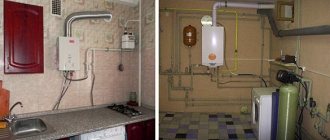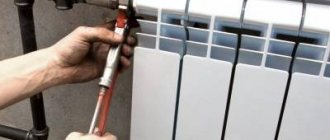In what cases and by whom is the riser in an apartment replaced?
The need to replace heating risers arises in three cases: if a major repair is being carried out, work is underway to replace the interior, its further operation is impossible for technical reasons. The last reason is typical for old-built houses, since the service life of the risers in them is close to critical. Most often, in these situations, the heating riser is replaced with polypropylene.
Current legislation states that replacing the heating riser in an apartment is the responsibility of housing and communal services, if we are talking about general building communications to which outlets to apartments are connected (attic and basement, entrances). The specified work is paid for by all owners. Moreover, the period for replacing heating risers in these cases is determined by law.
If the building in which your apartment is located belongs to the housing department, and the risers need to be replaced urgently (an emergency condition has arisen), the housing department employees will replace them. It is important to keep in mind that all pipes up to the shut-off valve, the first at the entrance to your apartment, common property, everything located behind it, must be repaired at the expense of the tenant.
The management company and the homeowners' association are entrusted with the responsibilities for carrying out maintenance and repair work at the facilities (see government decree No. 491, dated 08/13/06, as well as decree No. 170, adopted by the State Construction Committee of Russia on 09/27/03).
If you live in an apartment that you rent under a social tenancy agreement, then the risers in it are also required to be changed by employees of the management company or HOA, on their own and at their own expense. But if your housing is privatized, then you will have to carry out this work in full at your own expense.
Neighbors in Russia have always been more than just residents sharing an entrance and stairwell. They could become both closer relatives and angrier than enemies. Whether this is due to the communal heritage or the breadth of the Russian soul is not too important.
It makes sense that conflict situations between neighbors, alas, are the norm rather than the exception. And it’s understandable if we’re talking about music in the middle of the night, renovations in an apartment on a Sunday morning, or dirt in the entrance.
Sometimes conflict arises over things that are obviously for the benefit of all residents. For example, during a major home renovation.
We'll tell you in the article what to do if your neighbors refuse the planned replacement of risers.
What and who belongs in an apartment building - the rights and responsibilities of residents
Property relations of residents of high-rise buildings are regulated by Decree of the Government of the Russian Federation dated August 13, 2006 N 491 (latest edition dated November 23, 2019 “On approval of the Rules for the maintenance of common property in an apartment building...”
The document clearly states what exactly is not the private property of the apartment owner, but refers to common property.
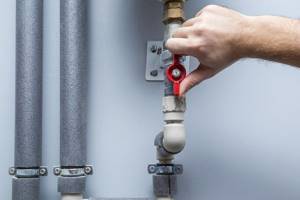
These are in-house water supply systems (hot and cold), which include:
— Water risers.
— Branches from risers to the first disconnecting device.
— The disconnecting devices themselves.
— Cold and hot water meters.
— The first shut-off and control valves on the branches of the intra-apartment wiring.
— Other equipment on these networks.
All this is spelled out in Article 1, paragraph 5.
The conclusion is obvious: water supply risers are not private property! This is common property located on the territory of the homeowners’ apartments. Therefore, the Management Company (or other authorized organization) bears responsibility for their serviceability.
According to the same Resolution, common property must be kept in a state of readiness for the provision of utility services. That is, to be able to provide water to the residents of the house.
The management company checks and prevents communications twice a year. Repairs them if necessary.
However, responsibility from residents is not completely relieved. The Housing Code of the Russian Federation of December 29, 2004 defines the responsibilities of the owner: to maintain this premises in proper condition, preventing mismanagement of it, to respect the rights and legitimate interests of neighbors, the rules for the use of residential premises, as well as the rules for maintaining the common property of the owners of premises in an apartment building.

The result is parity: the owner cannot do whatever comes into his head, and the management company undertakes to keep communications in good condition.
And now to the legal incident discussed in the article.
WHEN ARE RISERS REPLACED?
There are two possible options here, each of which has its own regulatory framework.
Replacement during major repairs.
The reasons are the expiring service life of the water supply system, an emergency condition or a planned replacement without any indication.
Repairs at the expense of the state (in fact, at the expense of your contributions for major repairs) are a good thing, but they may take a long time. Including due to the fault of obstinate residents who do not allow management company employees into the apartment.
Here it is worth knowing the following principle: According to Articles 44 and 46 of the Housing Code of the Russian Federation, major repairs of an apartment building are possible if 2/3 of the votes of the total number of residents are in favor of its implementation.
But the principles of democracy do not always work even within the same entrance. 1 or 2 apartments can interfere with the repair procedure (according to technology, each stage of replacing the riser affects three apartments).
Here's what to do:
Step 1. Try to negotiate.
If you need compelling arguments, refer to: - The Constitution of the Russian Federation, Article 17, Part 3. “The exercise of human and civil rights and freedoms must not violate the rights and freedoms of others.” — “Rules for the maintenance of common property in an apartment building,” which states that homeowners are obliged to monitor the condition of all communications and equipment, carry out repairs and restoration work in a timely manner.
Step 2. Contact the Management Company.
First, ask your neighbors to talk sense into things “without protocol.” If they do not heed, then a written request is drawn up for the Criminal Code to apply to the court to ensure access to communications. You have the right to monitor the actions of the management company and demand a report on the state of affairs. 5 days after registering the petition, representatives of the management company must tell the homeowners whether the claim was filed in court and at what stage its consideration is at.
Management companies may react slowly. This is unpleasant if the renovation has already begun and half of the entrance is in disassembled condition.
There will also be recourse against the Manager - a complaint to the Housing Inspectorate.
If the management company honestly went to court, then two options are possible:
— The court will make a positive decision and oblige the owner to open access. However, you will have to wait for the decision to come into force, and this is again wasted time.
— The court, in accordance with Article 212, Part 2 of the Code of Civil Procedure of the Russian Federation, may, at the request of the plaintiff, apply for immediate execution of the decision if, due to special circumstances, delaying its execution could lead to significant damage
for the claimant or execution may be impossible. The issue of immediate execution of a court decision may be considered simultaneously with the adoption of the decision.
This is a case when communications are in disrepair or failure to replace them threatens to flood the apartment of one of the residents. This is where bailiffs come to the aid of Criminal Code specialists.
There are also less legal ways - to turn off the water in the entire house. But in this case, it is not only the rebels who will suffer.
Replacement of the riser on personal initiative.
You can replace the riser during apartment renovation, if you agree with the management company and neighbors. This is true for old housing stock.
Here, too, the best option is to reach an amicable agreement with your neighbors. If it doesn’t work out, then your design ideas will not be the legal basis for gaining access to your neighbors’ apartment.

But if the riser and communications are in disrepair and are held in place only by pipe sealant, the law is on your side.
Firstly
, you can demand a replacement from the Management Company. Based on the Decree of the Government of the Russian Federation of August 13, 2006 N 491 “On approval of the Rules for the maintenance of common property in an apartment building...”.
Secondly
, replacement by one’s own forces is also carried out in agreement with the management company. Replacing risers qualifies as reconstruction (Article 25, Part 1 of the Housing Code of the Russian Federation) and requires appropriate changes to be made to the apartment’s registration certificate.
But please be careful.
ILLEGAL REPLACEMENT OF THE RISER can lead to:
• In case of an emergency (it is necessary to take into account the degree of deterioration of common property, the stability of the system, the material of the risers in the house, possible changes in pressure and temperature)
• To serious material losses if the accident occurs due to the fault of the owner who changed communications without permission. He will have to pay for the restoration of water supply and compensate for the damage to all victims.
• Problems with selling an apartment. Failure to comply with the technical passport with the actual layout and arrangement of the apartment will lead to a decrease in the market price and dissatisfaction of buyers.
When living in an apartment building, remember your rights and responsibilities. Their observance and execution - timely, correct, legal - is the direct and easiest way to order and a quiet life.
If you managed to reach an agreement with your neighbors or obtain the legal right to replace the riser, do not forget to use the sealing materials and knowledge base of our company.
Rules for carrying out work on replacing heating risers

In this case, it is allowed to replace the heating risers in the apartment with your own hands. If you have to change the valve itself, then permission from the Housing Office is required, which is issued on a paid basis. The most optimal solution when performing the above work is a one-time replacement of the heating riser with polypropylene on all floors at once (the entire span). But, in most cases, this wish cannot be realized. For some neighbors, the work is too expensive, others have already changed everything in their apartment, and others are quite satisfied with the condition that exists at the time you start the renovation work.
According to the existing rules for performing work, they must be carried out in the following sequence:
- The system is shut off and water is drained from it. This work must be performed by a housing mechanic. If the work is emergency, the riser will be closed free of charge. In all other cases, you will have to pay a state fee.
- A grinder is used to cut out old riser pipes in an apartment. In this case, the technology of subsequent work should be taken into account.
- If the riser is changed along the entire span, then the pipes are cut in such a way that they can be conveniently removed from the ceiling;
- The installation locations for new heating devices are being outlined.
- Radiators are installed in place and leveled. Otherwise, air will accumulate in them.
- After installation, pipes are connected to the radiator, going, respectively, to the upper and lower neighbors.
- A jumper is installed to block the area in the event of a leak.
- The riser starts.
When neighbors have prohibited them from performing any joining work, the pipes should be cut in such a way that the remaining part can be threaded (at least 6 turns) and a transition coupling can be installed.
If your neighbors have a metal riser and they allow you to connect to them, then it’s better to cut in right here, it’s easier to get through the ceiling.
If your neighbor has a riser made of plastic pipes, in this case you should also choose plastic pipes of the same diameter and connect to the neighbor through a special coupling. If you are planning a metal riser, then you will have to make a threaded fitting, fixing the position of the riser in the neighbor’s apartment. Otherwise, you can turn its riser and you will have to make repairs on it too.
Scheme for replacing risers in a house or apartment
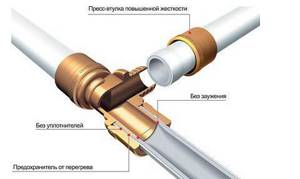
Replacing a cast-iron riser with a plastic one in a private house technically differs from similar work in an apartment only in that in the first case there is no possibility of obtaining a bunch of approvals and permits. Therefore, we consider this issue using the example of work in an apartment.
Replacing risers in an apartment building: at whose expense?
Property owners in an apartment building can no longer cope without an installed sewerage system, water supply and heating system. Only any communications need to be repaired periodically.
Even a non-professional will be able to do internal pipe routing, but he is unlikely to be able to replace communications along the riser.
At whose expense is the replacement of risers in an apartment building carried out?
Many people ask the question: who should pay for the replacement of risers in each individual apartment? People still continue to argue about this, but they cannot come to a consensus. Only lawyers can solve this riddle. However, first you should familiarize yourself with all the various versions being discussed.
Some believe that all residents are required to pay equally for the replacement of the riser. According to another version, only those citizens who express a desire for a replacement should pay for this.
There is also an assumption that the developer must carry out these repairs. In this case, people would not have to pay for anything at all. So which of the judgments is true?
There can be only one answer: the housing maintenance office must replace risers in apartments at its own expense, without involving citizens in this. There is a legal basis for this judgment.
As for the water supply or sewerage system in multi-storey buildings, these are public facilities, although they are relevant to each property owner individually. This statement is enshrined in law; you just need to read Art. 290, 292 of the Civil Code of the Russian Federation and paragraph 5 of Art. 36 and art. 155 Housing Code of the Russian Federation. But everyone is ready to pay for this service out of their own pocket.
Every month in rent receipts you can find the amount that is collected from citizens for the maintenance and repair of the same risers and pipes. Therefore, when an unexpected breakthrough or other emergency occurs, the housing office must urgently replace it. The housing office has no right to demand money from people, since they have paid everything in advance, and maybe even for several years in advance.
If you receive a refusal, you should request it in writing. Now, having in hand a document in which the Housing Office refuses to replace the risers, you can go to court. True, you will probably have to wait more than one year until the court makes a decision. In this case there are only two options.
Firstly, you can wait for a serious accident, as a result of which the entire entrance will be flooded, and the repair team will have to do their job. Although in some cases, housing office workers simply weld the problem area, instead of replacing the riser completely.
Secondly, you can organize a general meeting of apartment owners and resolve the issue of high-quality replacement of pipes, but at your own expense. You will have to pay 3-5 thousand rubles from each apartment. In addition, you can solve the issue with pipe routing, which is missing in the bathroom.
The procedure for replacing risers in an apartment building
Each house has risers installed:
- heating system;
- sewer;
- for supplying hot and cold water to the apartment.
Each of them must be replaced in a certain sequence. The following list of works is expected:
- covering the riser being repaired. In any case, when it comes to water supply pipes, you still need to wait until the remaining liquid flows through the system. If we are talking about replacing a sewer riser, then you need to warn all residents of the house so that no one drains the water at this moment, and shut off its supply;
- removal of old pipes, dismantling. You should agree with the management company to use professional plumbers, since old pipes will have to be removed from the interfloor. This is a very labor-intensive procedure, especially if the pipes were made of cast iron;
- installation of new pipes. At this moment, you need to open the water and monitor the water supply process for leaks.
The best option is to simultaneously replace communications throughout the house. This will allow you to avoid future possible leaks and emergency situations that may arise after installing a new riser in only one specific apartment.
Although the principle of work for replacing communication systems is the same everywhere, there are still some peculiarities.
When replacing the heating riser, you must:
- notify the management company about the need to turn off the heat supply. Without certain knowledge regarding the location of the valve itself, you will not be able to close the riser;
- when connecting the batteries, you need to think about installing shut-off valves, so that in case of a leak you will not have to shut off the heat supply to the entire house;
- When replacing pipes, you should not resort to extreme measures and narrow their diameter, otherwise a breakthrough may occur, given the certain pressure in the central heating system.
When replacing a water riser, the correct type of pipe is of particular importance. There is a difference between the supply of cold and hot water, since in the second case there is a need to install reinforced plastic pipes. They will not deform at high temperatures.
It is better to carry out the procedure for replacing pipes throughout the house, but if the neighbors do not want to do this, then the master must cut off the old pipe in the apartment in front of the ceilings, upper and lower. Next, special fittings are installed.
When replacing the entire riser, it is necessary to ensure that dismantling is carried out starting from the apartment on the top floor. However, installing a new riser definitely starts from the bottom.
In the case when the neighbors are in no hurry to replace the riser, you can simply cut off the pipe at the floor and ceiling, and then install a branch that is installed in the remains of the old pipe.
No comments yet
o-nedvizhke.ru
What is a heating riser
A heating riser is a pipeline that connects the elements of the system and ensures normal circulation of coolant in heating devices. Risers can be supply or return. The former dilute the coolant into the radiators, and the latter collect and remove the cooled liquid. In a one-pipe system, one heat pipe performs both functions.
The coolant can move in two directions: from bottom to top and from top to bottom. In centralized heating systems, special compensators are installed on the main risers. To urgently stop the heating system, shut-off valves are installed.
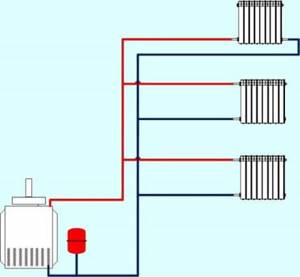
What are pipes made of?
Pipes used in heating systems must withstand high temperatures and severe pressure surges. Several types of materials meet these requirements:
- steel;
- copper;
- metal-plastic;
- polypropylene;
- cross-linked polyethylene.
Each of the materials has its own advantages and disadvantages. Steel is durable, can withstand a coolant temperature of 95 degrees, but is expensive, wears out quickly, and is difficult to install. Copper is very expensive, but it lasts for several decades and is highly resistant to all negative influences.
When installing modern heating systems, metal pipes are used less and less. They were replaced by metal-plastic, polypropylene, and polyethylene. Synthetic materials are resistant to high temperatures, pressure and corrosion, have high thermal conductivity, and are well suited for hidden installation.
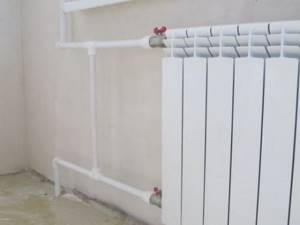
Cross-linked polyethylene is a new promising material on the construction market
Products made from cross-linked polyethylene attract special attention from buyers. This is an innovative material with which you can install an almost eternal heating system. It is not afraid of corrosion, pressure, or high temperatures. Pipes made from it are thin and light, but at the same time very durable.
The main advantage of cross-linked polyethylene is its high ductility: it can withstand high loads and quickly takes its original shape. Thanks to this property, pipes do not flow at the joints, which makes the material ideal for hidden installation. The only drawback is the high cost of the material itself, connecting elements and tools for installation.
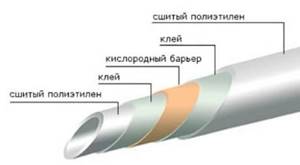
Causes of failure and leaks, burst pipes in heating risers
- So, the most obvious reason is dilapidated, old pipes.
- Incorrect installation of pipes, their improper repair and maintenance: leakage in a threaded connection - poor sealing of the connection, broken threads, cracks in the connecting fitting;
- leakage in the flange connection - loose bolts, faulty gaskets and distortions in the flanges;
- leakage in welded joints - poor-quality welding work.
What to do when a small leak appears and how to repair it yourself (clamp, sealant). Repair of metal, plastic, cast iron and copper heating risers
If you need to make minor repairs to a metal pipe on its straight section or in a weld, you can use epoxy (emergency) glue and fiberglass. Before repairs, be sure to clean the damaged area of old paint, clean and degrease the pipe. Apply glue and, if necessary, additionally strengthen with a metal clamp. They can be purchased in different sizes on the market or in building materials or plumbing stores. A clamp is a rubberized pad with a pair of rods, consisting of a pair of screws, which, in principle, can be made with your own hands. You will need a strip of thick metal, a rubber pad, washers, nuts and bolts.
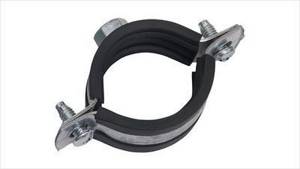
Figure 1. DIY clamp
*
Or we wrap the area with a piece of rubber and secure it with wire.
You can use sealant. Then we repeat the previous steps (clean, degrease) and apply the sealant clockwise.
If a leak has formed in the places where the elements of the heating system are attached, you just need to tighten the fitting using a special wrench.

Figure 2. Leakage at joints
Didn't help, is it dripping? The reason may be wear and tear of the tow. In this case, it is necessary to press the fitting halfway, remove the old tow, clean the threads and wind a new one. However, be careful! Pressure in the pipes can cause a rupture of the connection and a flood.
Still leaking? The thread of the part may be damaged. In this case, call a specialist, and before he arrives, wrap the leak area (preferably with a piece of rubber).

You can wrap the area with water in a bandage, generously sprinkling each layer with ordinary table salt, which clogs all the cracks.
Another option to seal a leak (if the area is small) is to wrap the problem area with a cloth soaked in glue.
To prevent leakage in the threaded connection, you need to cover it with several layers of paint.
Repair of a copper heating pipe may be necessary when the metal delaminates. The solution is high-temperature brazing using hard solder. If minor damage occurs at the bends, low-temperature welding with soft solder is used.
Before repairing, it is important to first clean the area of dirt and degrease it.
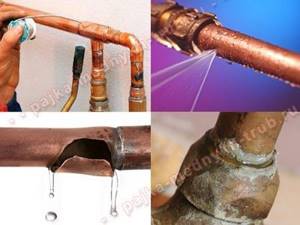
*
You may need to repair the fitting that connects 2 sections of pipe. In this case, replacing the nut or gasket may be sufficient.
When repairing plastic heating pipes, the damaged element is replaced with a new one.
If it is not possible to make a replacement, you can wrap a special reinforcing plastic pad around the damage and melt it with a welding machine.
So, to summarize the above, we will indicate what actions are included in the repair of the heating system:
- eliminate leaks in devices, fittings and pipelines,
- replace a separate section of the heating device, tap,
- insulate various devices and pipes that are located in cooling or open areas,
- eliminate reverse slopes on pipelines,
- install additional fasteners,
- troubleshoot the boiler,
- replace measuring instruments,
- clean and rinse elevators, expansion tanks, control and shut-off valves,
- flush the air intake system and adjust them.
Features of placing risers in rooms
Heating risers are located near the external walls. If the room is corner, then it is better to place the riser in the corner to protect the walls from cooling and becoming damp. It is taken into account that the riser:
- They are installed simultaneously with heating devices or after their installation.
- Do not place near flammable materials. At a coolant temperature of 105 degrees, the distance to such materials should be at least 10 cm.
- In single-pipe systems, the riser is placed 15 cm from the window opening with connections about 40 cm long.
- If the distance to the heating device is less than half a meter, then it is not necessary to make a slope, but if it is greater, then the slope is 5-10 mm towards the battery.
- In houses with several floors, fastenings depend on the height of the floors. At a height of less than 3 m, no fastenings are installed. If the height is greater, then the fastenings are mounted at half the height of the floor.
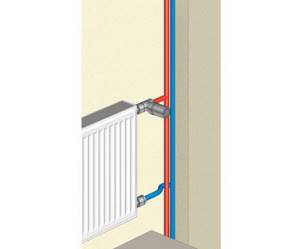
Refusal to replace pipes
Residents of a house are not always ready to replace pipes, especially if it does not involve an urgent emergency breakdown. Let's figure out whether it is possible to refuse to replace the risers during a major overhaul.
The reluctance to carry out repair work is explained by the fact that these actions can cause property damage to the apartment owner. The repairs in the bathroom or other room will simply be ruined for him.
Paragraph 5 of Government Resolution No. 491 states that homeowners do not have the right to prevent management companies and emergency services from inspecting the current condition of equipment and making repairs.
This is a violation of the law. Residents do not have the right to refuse major repairs to replace risers. Control inspection according to standards is carried out once every 90 days, emergency inspection - at any time.
In response to residents’ refusal to carry out repairs, employees of the management company or housing and communal services will have the right to file an application with the court.
What to do if the management company refuses?
How to force the management company to replace the heating risers if it deliberately evades its responsibility?
There are two ways to force a negligent management company to act:
- Write an application to the management company and put a mark on your copy indicating acceptance of the document. If there is no response, you can file a complaint with the Housing Authority. If you can’t get the truth here, you can go to court. It must be taken into account that litigation will lead to large temporary losses.
- Replace the riser in your apartment at your own expense. The main thing is to save all receipts for expenses so that you can later present them to the management company for reimbursement.
If the management company wrote to the applicant a reasoned refusal stating that the communication heating system is in good working order, it will be possible not only to appeal the actions of the management company, but also to recover the amount of damage from them.
A situation is possible when, on the contrary, the management company has to force the tenant to replace the riser . Then the management company can also file a lawsuit if, for example, one of the neighbors did not want to participate in replacing the heating system.
How to change a heating riser with your own hands
Most often, polypropylene is chosen for modern heating systems. It is affordable, looks nice and has good technical and operational characteristics. For the owner of an apartment in a multi-storey building, the ideal option is if the neighbor above has already changed the heating pipes to polypropylene ones. If not, you will have to negotiate with him to connect the riser. If no one lives in the apartment, you will not be able to start the heating system after replacing the pipe.
How to turn off the heating riser before replacing
If the coolant rises from below in the system, the risers are connected in pairs. To figure out which neighbor's riser yours is connected to, go up to the neighboring apartment and look at how the jumpers are placed. If the coolant supply comes from above, then to turn it off you will have to close two valves - in the attic and in the basement.
To find the right valve, it is important to correctly identify the entrance, after which the location of the required one will become obvious. After closing the valve, you need to unscrew the plugs, open the vents and wait for the water to drain from the system.
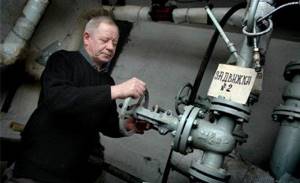
Replacing metal with polypropylene
If the neighbor has already changed the pipes, then no problems will arise at all. Buy pipes of the same diameter. Cut off the old riser, insert a new pipe into the ceiling and connect to the pipe of the neighboring apartment through an adapter coupling. Next, remove the foil layer from the pipe. Unscrew the old pipe from the radiator and install the faucet. A transition coupling is installed in it and connected to the riser.
Preparing for work
Replacing heating risers with your own hands requires careful preparation for the work; only under this condition will no extra money and effort be spent, and the work itself will be of high quality.
Important! It is recommended to replace the riser pipes completely, not partially - only in this case will the heating system operate efficiently. Therefore, before changing the riser, it is necessary to calculate and purchase a sufficient amount of material.
First of all, you need to come to an agreement with the neighbors living above and below. Replacing heating risers should be carried out from the exit from the upper radiator to the entrance to the radiator of the neighbor living below - this would be an ideal option. If it is not possible to reach an agreement with the neighbors, then the old heating riser will be cut off under the ceiling and near the floor, and the replacement of pipes in the riser itself will take place within the same apartment.
The space where the risers will be replaced should be cleared and all flammable and breakable objects removed. The water supply must be turned off throughout the riser, and neighbors should also be warned about this in advance.
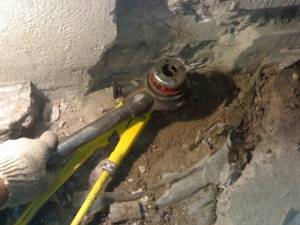
But simply shutting off the riser will not be enough; you will also need to drain excess water from them. All this work must be performed by housing office employees, usually for an additional fee.
What you need to start working with galvanized materials
The first step is to purchase galvanized pipes DN20 in the required quantity. In addition, a mandatory element of all work will be a welding machine, without which it is impossible to repair risers in an apartment building.
Gas welding can greatly facilitate the work, especially if installation conditions are difficult. If you have a welding machine, it is worth purchasing long and short threads. Shut-off valves and a radiator will be attached to them.
In addition, you will need:
- three locknuts for the radiator;
- three runs, which will go one at a time to the jumper and liners;
- two cast iron or brass tees;
- two couplings;
- three valves for DN20 pipe.

The latter are needed to control the heat in the room, since they can block or limit the flow of water into the battery. In addition, you should purchase only ball valves, as they are the most convenient to use.
Who should change/repair them and when?
Maintenance of the heating system involves 2 types of repairs - current and major.
- The first type includes work to eliminate minor problems that do not require significant costs. They are carried out at the request of residents, as needed.
- Major repairs include general house-wide measures to ensure the operability and safety of the entire system. The procedure for its implementation is stipulated by Chapter 15 of the Housing Code of the Russian Federation. Replacing heating risers belongs to this type of repair. It is carried out according to a schedule, taking into account regulatory deadlines, in the event of an emergency or to modernize the system.
The management company is responsible for carrying out planned capital and current repairs. She, of course, does not conduct it herself, but with the involvement of a specialized organization. Unscheduled events of this type are carried out by decision of the general meeting of residents. Next, the application is submitted to the management company, which ensures their implementation.
Read more about the types and costs of major and other types of repairs of heating systems in an apartment building here.
Beginning of work
The first question that arises is: how to turn off the flow of water in the heating riser?
The answer to the question will be the design of water bottling in a residential building, which can be:
- top;
- bottom.
In the first case, you will need to turn off the water, both in the attic and in the basement. During bottom filling, the risers are connected in pairs, so you will have to find the adjacent riser with the one you need. To do this, you will have to go into the apartment from above and look at the location of the jumper (read: “Installing heating pipes in an apartment - the main types of material”).
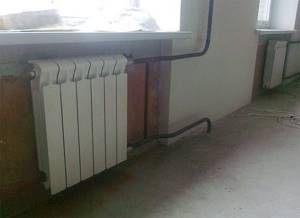
After turning off the water, you will need to remove the plugs and drain the water. In addition, during the heating season, this operation cannot be performed if it is impossible to go to the apartment on the floor above, since it will be impossible to resume the heating cycle. The reason is simple: air will accumulate in the radiator, which cannot be released without access to the battery.
Removing the old riser
The easiest way is to remove the old riser by cutting off their liner with a turbine. After this, you should tighten the locknuts and unscrew the remaining lines from the radiator.
In order to determine where to cut the riser, several facts should be taken into account:
- if you have good relations with your floor neighbors, you can come to their apartments and remove part of the pipe in the concrete gap, since usually all leaks occur in this area;
- for ease of work, it is better to cut the pipe above the floor and below the ceiling, as this will leave more space for maneuver. In addition, this will make it easier to replace the tubes later if necessary.
Correct thread installation
So what you need to pay close attention to
- Using a file or turbine, it is necessary to remove the chamfer, after which an entry for the die will be made.
- The die with the holder on the long side is placed on the tube. This operation is necessary for a perpendicular entry of the die onto the pipe.
- Short threads are applied to the riser, not exceeding five threads. The thread is applied strictly clockwise.
- When the die approaches the edge of the tube, it is worth pressing the holder as powerfully as possible with all your might.
- After cutting the first thread, you need to hold the riser with a gas wrench. The maximum force is applied so that the rotational moment of the die can be compensated, since otherwise it will be possible to break the thread of the riser on the floor above or below.
- If a convector is mounted for welding, then there is no need to hold the structure, since it is impossible to tear out such a riser.
- It is necessary to cut a long thread on the connection to the radiator and on the outlet in the jumper.
- During the cutting process, a piece of tube must be fixed with a vice in order not to destroy the structure of the already cut thread.
Riser assembly
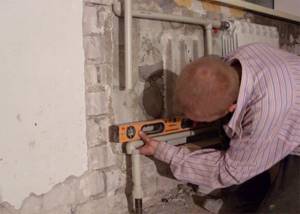
- Pipes, cut in the required places and having threads on both sides, will need to be passed through the ceilings, after which they are connected by couplings with threads on the riser. As a winding, it is better to use plumbing linen with paint or silicone sealant. In addition, replacing the heating riser in an apartment can also be done using a polymer thread.
- The second option will be cheaper, but given that the work is being done for a long time, it is better to use flax with a sealant, since the first guarantees tightness, and the second can neutralize the effects of fading and rotting.
- Next, you need to screw the tees onto the threads. It is worth maintaining a distance of 50cm between the internal threads in order not to subsequently install the eyeliner under tension. The latter looks ugly, in addition, it ensures that the locknut is skewed, as a result of which a large amount of water and heat will come out.
- Valves are screwed into the tees.
- In the valves that cut off the radiator, it is necessary to screw in long pipes (pipes with a short thread on one side and a long thread on the other). The locknut and radiator cap are installed on them until they stop.
- It is worth mounting the jumper in the same way as the squeegee, namely, it is important to screw a long thread with a lock nut screwed all the way into the tee. Next, the short thread, which is aligned with the thread of the valve, is wound up and screwed into the latter, but at the same time, the long thread must be turned out of the tee to the length of the short analogue. The last step is to rewind and tighten the locknut.
- After all the manipulations, you can proceed to connecting the radiator. It is hung on brackets so that the axes of the connections coincide with the axes of the threads for the plugs (read: “Replacing a heating radiator in an apartment - process guidance”). After this, it is necessary to fit the previously wound plugs into it. The same thing should be repeated with locknuts.
When the question is whether to change risers or not
- Installation of new risers;
- Wiring connection, monitoring the correct operation of the system.
- Features of replacing pipes and risers of the heating system Tip: when replacing heating pipes, it is necessary to enlist the support of neighbors both above and below. Because there will be no sense if the old risers remain in the ceilings. Replacing a heating riser in an apartment includes the following steps:
- shut off the risers and drain the water from them (you must contact the housing office);
- cut out old pipes with a grinder and dismantle them by pulling them out of the floor slabs;
- mark the battery installation locations;
- install the battery using a level and a hammer drill;
Installation of heating pipes Tip: it is necessary to install the battery only level, because if it is skewed, air will collect in the heating radiator and it will not function well.
He does all this of his own free will and at his own expense. This does not raise any surprise or doubt about the legality of such actions. Ownership includes the ability to make such changes and improvements.
But when it comes to replacing risers, that is, those thick pipes that connect all floors and apartments into a single whole, opinions differ. Residents believe that the management company is responsible for the common property, but that company says that since this is the common property of the apartment owners, everything related to the replacement or repair of pipes is their responsibility. Let's try to figure out who is right. Who should change the risers in a privatized apartment? It is worth remembering that in addition to the right of ownership, there is also the so-called burden of the owner, which consists in the need to maintain his property in good condition and pay for its maintenance.
But confirmation of the fact that all pipes, including water, heating, gas and sewer pipes are the property of the residents of the house, does not answer the question of who should change the risers in a privatized apartment? The same document talks about such a concept as repairs (current and major). The definition of routine repairs given in the Rules for the Technical Operation of Housing Funds includes the following items regarding all pipelines inside a residential building, such as:
- installation;
- replacement;
- restoration of performance.
Responsibilities of the owner According to the Rules, making decisions about the need for routine and especially major repairs lies with all owners.
Starting the heating riser
Regardless of how many heating risers there are in the apartment, the operation for starting them always remains the same:
- first the design is pressure tested;
- Next, water is pumped into the radiators and the riser is checked for leaks (for more details: “Start the heating - we start the system according to the rules”).
To carry out pressure testing of the structure, it is worth finding an assistant. In addition, you can take a photo of all the joints in advance, since the slightest changes will be difficult to notice at first glance, but in comparison with the initial design it will not be difficult to find flaws (
What to do if the air cannot be displaced?
Unfortunately, an unusual situation may occur and usually working methods will be powerless. This may be due to the absence of neighbors above or the unusual design of the house, but you should always be prepared for the fact that it is not always possible to restore the heat supply to the apartment immediately.
Experienced craftsmen use moving the riser to discharge, as in most cases this allows circulation to be restored. Manipulations are carried out either over plugs or over valves.
To do this, you need to open the valve on one riser, and the vent on the second riser. In this case, the air will leave the battery along with the water. If there is no result, you should perform the same steps, but in the opposite direction.
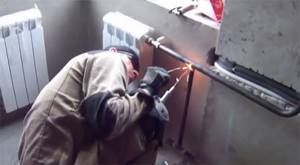
It is worth noting that this technique is especially effective if aluminum or bimetallic radiators are used in the house, since they do not retain air, unlike cast iron analogues, which are prone to creating plugs, so there can be much more problems with them.






